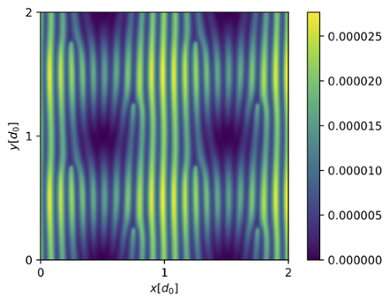Stripes give away Majoranas

Majorana particles have been getting bad publicity: a claimed discovery in ultracold nanowires had to be retracted. Now Leiden physicists open up a new door to detecting Majoranas in a different experimental system, the Fu-Kane heterostructure, they announce in Physical Review Letters.
Majorana particles are quasiparticles: collective movements of particles (electrons in this case) which behave as single particles. If detected in real life, they could be used to build stable quantum computers.
"Majoranas are quantum mechanical superpositions," explains Gal Lemut. This superposition, a special kind of combination, comprises an electron and a hole (a place in a crystal where an electron is missing.
"Majoranas have no electric charge, no spin, and zero energy," adds co-author Michał Pacholski. This makes having no defining characteristics one of their defining characteristics. "So it's very difficult to detect a Majorana," says Pacholski.
Clingy Majoranas
One of the first systems in which they were predicted to exist, was the so called Fu-Kane heterostructure. "It's a topological insulator layered on a superconductor," says Pacholski. Topological insulators, which conduct current only on their surface, have been a major focus of recent physics research. Superconductors are materials which conduct electricity without any resistance.
Earlier research by Liang Fu and Charles Kane predicted that Majoranas will appear when a Fu-Kane heterostructure is placed in a magnetic field. Superconductors will expel magnetic fields, through the so called Meissner effect.
This means that the magnetic fieldlines pierce the superconducting material in pillar-like-vortices, where the superconductivity vanishes locally. Majoranas will cling to these vortices, Fu and Kane predicted. Experiments have so far matched up their predictions, but definitive proof for the Majoranas is still lacking.
A welcome comeback
The Leiden theorists decided to analyze Fu-Kane materias, and proved that adding an electric current could make a crucial difference. "The Majoranas delocalize," says Lemut. "This means that they spread out beyond their vortices, and they might meet each other."
Since Majoranas are their own antiparticles, and can annihilate each other, this interaction might be expected to destroy them. But according to the paper, this is not the case: "They continue to exist as separate Majoranas," says Pacholski, "which is quite surprising."
The finding may bring the detection and eventual use of Majoranas one step closer. "The next step would be to convince an experimental physicist to check it. It't hard to prove the existence of Majoranas, but our paper offers a clear signature: The holes and the electrons within the Majoranas would interfere with each other. This gives a characteristic striped pattern," says Lemut.
If you detect this pattern, that would would mean a clear and welcome comeback for the Majorana.
More information: M. J. Pacholski et al, Deconfinement of Majorana Vortex Modes Produces a Superconducting Landau Level, Physical Review Letters (2021). DOI: 10.1103/PhysRevLett.126.226801
Journal information: Physical Review Letters
Provided by Leiden University





















